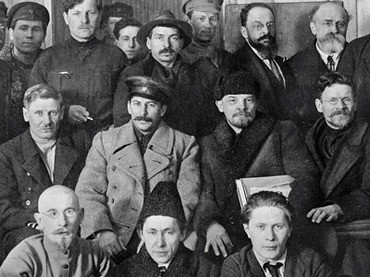
The Bolsheviks and Mensheviks were Russian revolutionary parties of Marxist origins. Russian Marxism dates back to 1898 and the creation of the Russian Social Democratic Labour Party, or SDs, which itself was formed from several smaller groups. By the turn of the 20th century, the SDs were Russia’s largest Marxist party. In its first few years, the party platform of the SDs remained true to Marxist theory. The SDs considered the proletariat (industrial working class) to be the natural source of revolutionary energy. Since Russia’s industrial workforce was still small, socialist revolution in Russia was a distant prospect – decades, generations, perhaps even a century away.
Lenin also railed against the party’s democratic decision-making processes. Revolutionary parties should be organised and directed by ideology, theorists and professionals, he wrote – they should not be steered by the masses, who almost always vote to accept concessions or improved conditions. Lenin argued for a party that was small, dedicated and secretive. Its membership would be restricted to ‘professional revolutionaries’; its decisions made by an intellectual elite. This party would be the vanguard of the revolution, leading the way.

Lenin’s theories on party membership and organisation attracted some support from members of the SDs, while others adhered to the status quo. This led to divisions within the party which manifested at its Second Congress in August 1903. Lenin called for a vote on some of the issues he had raised in his book the previous year. Lenin’s chief rival, Julius Martov, argued that the SDs should remain decentralised, with membership open to all workers.
While most of Lenin’s points were defeated, he narrowly won the vote on party membership, 24 votes to 20. Most of those who voted with Lenin were young (the vast majority were under 30) and politically radical. Collectively, Lenin’s supporters became known as the Bolsheviki, derived from the Russian word bolshinstvo (‘majority’). In some circles, they were also known as ‘Maximalists’ or ‘Leninists’. Those who voted against Lenin were later dubbed Mensheviki (from menshinstvo, or ‘minority’).
“The Mensheviks perceived themselves as orthodox Marxists. They firmly believed in Marx’s stages of economic development. Socialist revolution could not succeed in a country where capitalism was still rudimentary; a premature revolution was bound to fail. This view was fortified by the Mensheviks’ interpretation of the revolutions in recent European history… The lesson drawn was that in a future revolution, the socialists should strive only for what was achievable at the given historical stage of development; they must postpone socialist changes and concentrate instead on establishing a bourgeois-democratic order – a parliamentary republic and democratic government elected by universal suffrage.”
Vladimir Brovkin, historian
Gifted with talented people like Martov, Plekhanov and Trotsky, the Mensheviks enjoyed high levels of support amongst urban workers and were a viable political force between 1905 and 1917. Throughout this period Menshevik figures were more visible and influential than the Bolshevik leadership, most of whom were in hiding, under arrest or in exile. The Mensheviks stood candidates for the Duma; worked with the Provisional Government; and strove for improvements for Russian workers. The Mensheviks also retained control of the SD newspaper Iskra (‘spark’), forcing the Bolsheviks to begin their own publication. While the Bolsheviks were slow to respond when a revolution erupted in 1905, in part because Lenin was still in exile, the Mensheviks took a lead role in the trade unions, workers’ groups and, importantly, in the formation of the St Petersburg Soviet, where they enjoyed a sizeable majority.

1. The Bolsheviks and Mensheviks were socialist parties that began as factions of the Social Democratic party.
2. The Social Democrats were divided over issues raised by Lenin at its 1903 party congress.
3. Lenin’s faction, the Bolsheviks, wanted a party of professional revolutionaries and limited membership.
4. The Mensheviks remained truer to Marxist principles, preferring a broad-based party with open membership.
5. The split became permanent in 1912 and the two parties took radically different paths towards revolution.
© Alpha History 2018. Content on this page may not be republished or distributed without permission. For more information please refer to our Terms of Use.
This page was written by Jennifer Llewellyn, John Rae and Steve Thompson. To reference this page, use the following citation:
J. Llewellyn et al, “The Bolsheviks and Mensheviks” at Alpha History, https://alphahistory.com/russianrevolution/bolsheviks-and-mensheviks/, 2018, accessed [date of last access].
